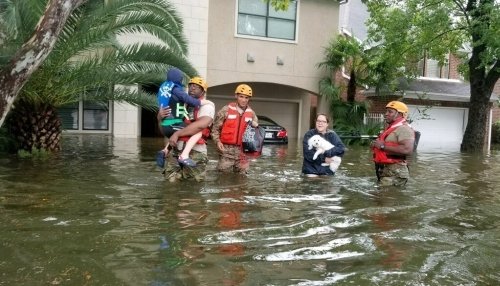Torrential rain can be one of the most devastating consequences of hurricanes, especially in urban areas where concrete makes it harder for water to drain and where people can drown.
Hurricane Harvey, which stuck the Gulf Coast of the United Sates in late August, dumped an estimated 125 trillion litres (33 trillion gallons) of water on the U.S. making it the wettest storm in U.S. history. 60.58 inches of rain was recorded in Nederland, Texas - surpassing the U.S. record for one storm, set in Hawaii in 1950, by 8 inches!
U.S. Soldiers aid citizens in a heavily flooded area of Houston
(public domain image)(
 )
)Meteorologists define “heavy rain” as anything greater than 0.3 inches an hour. According to NASA, Hurricane Harvey's rainfall reached as high as 5.8 inches an hour. Harvey was followed by Irma which which dumped 10.8 inches an hour on Cuba and an incredible 15.8 inches an hour on Florida. And then Maria dumped up to 6.4 inches an hour on Puerto Rico.
75 people died as a result of Hurricane Harvey - most of them by drowning.
Why this is happening is clear. Higher temperatures cause ocean water to evaporate. Each degree centigrade adds about 7% more water vapour to the air. When the air cools in a storm, this extra water vapour produces heavier rain. Sea surface temperatures around Houston have risen around 0.5 °C in recent decades, which has caused a 3–5% increase in moisture in the atmosphere.
And the warming has only just begun. The best case outcome from the from the Paris Accord would be 1.5 °C warming. So, expect more and worse extreme weather.
The possibility of plausibly denying that the climate is changing has long passed and the insanity of allowing vested interests to worsen the situation by promoting the use of fossil fuels becomes clearer every day.
One lesson that we can draw from these events is the value of open ground and wetlands together with the preservation of rivers and other water channels to absorb water and allow it to escape.
Rapid urban development around Houston has seen absorbent prairie and wetlands replaced by hard surfaces which rapidly shed storm water and overwhelm the drainage capacity of rivers and channels. Between 1992 and 2010 almost 25,000 acres of wetlands around Houston were lost, decreasing the detention capacity of the region by four billion gallons.
Let's talk about it.
Also posted on my GreenBiz Cafe web site at https://www.greenbizcafe.com/?p=6826
This item was based on various sources including the U.S. National Weather Service and Wikipedia.
Very nice completion of post! @thegoodtrooper
Thanks, @fantasticmonkey and thanks for resteeming!
Hey trooper,
Very well written and researched. I live in the Houston area , we were not flooded but had several friends that had water in their houses over six feet deep.
Every thing you say with regard to the growth is absolutely correct. The civil engineering with regard to water run off has been lacking greatly and the expansion continues.
Until next time,
@sultnpapper
Unfortunately, it's pretty much the same in big cities everywhere.
Congratulations @thegoodtrooper! You have completed some achievement on Steemit and have been rewarded with new badge(s) :
Click on any badge to view your own Board of Honor on SteemitBoard.
For more information about SteemitBoard, click here
If you no longer want to receive notifications, reply to this comment with the word
STOPCongratulations @thegoodtrooper! You received a personal award!
You can view your badges on your Steem Board and compare to others on the Steem Ranking
Do not miss the last post from @steemitboard:
Vote for @Steemitboard as a witness to get one more award and increased upvotes!